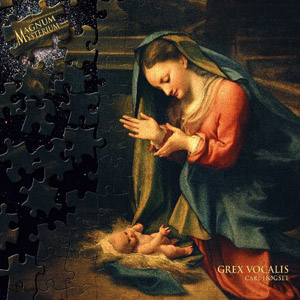 Magnum Mysterium is a collection of choral music around the celebration of the birth of Christ – the “Magnum Mysterium” that has provided such a rich heritage for Christmas celebrations. Although Grex Vocalis is a Norwegian group, the disc also offers carols from France and England and includes a “Norwegian” hymn, “The Infant King,” that originated in the Basque country. The songs themselves range all the way from traditional Norwegian carols and hymns to works by Michael Praetorius ((1571-1624) to contemporaries Morten Lauridsen and Javier Busto. With these resources to draw on, it would seem that there is potential for a joyful and compelling offering.
Magnum Mysterium is a collection of choral music around the celebration of the birth of Christ – the “Magnum Mysterium” that has provided such a rich heritage for Christmas celebrations. Although Grex Vocalis is a Norwegian group, the disc also offers carols from France and England and includes a “Norwegian” hymn, “The Infant King,” that originated in the Basque country. The songs themselves range all the way from traditional Norwegian carols and hymns to works by Michael Praetorius ((1571-1624) to contemporaries Morten Lauridsen and Javier Busto. With these resources to draw on, it would seem that there is potential for a joyful and compelling offering.
I will be perfectly honest here: although a non-Christian, I have been known to find myself moved to tears at a heartfelt rendering of “O Holy Night” by a small church choir. The singers of Grex Vocalis are polished, the arrangements are apt, and the music itself is often very beautiful. However, it is not until a performance of Palestrina’s “O Magnum Mysterium” (the ninth track) that one senses any real involvement on the part of the performers. Palestrina’s setting of the traditional text is itself quite compelling, building counterpoint on polyphony to a wonderful richness of sound. It seems as though that song, somehow, caused the ensemble to reach critical mass: the tracks immediately following, “Kling no Klokka,” (“Ring, Bells”) a traditional Norwegian melody, and the French carol, “Les Anges dans nos campagnes” (often known in the U.S. as “In Excelsis Deo“) lead to a series of beautifully performed tracks of varying moods and histories. The performance of Francis Poulenc’s “O Magnum Mysterium” is suitably rarefied and occupies that realm of spirituality that seems to be a particular domain of twentieth-century French music, while Michael Praetorius’ “Det Hev Ei Rosa Sprunge” (“A Great and Mighty Wonder”) reminds me of why I am so fond of Praetorius. Javier Busto’s setting of “O Magnum Mysterium” begins sotto voce with a simple, lovely melody that builds in a slow crescendo to a fully justified “Alleluia!”
Perhaps symptomatic – or at least illustrative – of my reaction to this recording is the choice of Correggio’s Adoration of the Child as the cover illustration: polished, beautifully rendered, and a bit empty. The singing by the ensemble is accomplished and often quite lovely, but it took awhile before I believed them. Tenor soloist Magnus Staveland has a wonderful voice, with a somewhat dark timbre (there is, perhaps, a future Tristan here: he seems to have that “proto-Heldentenor” quality); it would be wonderful to hear him really sink his teeth into something. The ensemble as a whole (founded in 1971 by conductor Carl Hogset) is fluent and, as noted in the notes, “renowned for its smooth, even sound.” That may be something that works against it in this collection: if it comes to a choice between passion and polish, I will take passion.
(2L, 2004)
